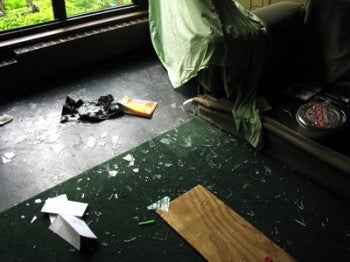Upper Holmesburg residents glad to see Liddonfield go

As part of a two-part series, NEast Philly goes inside two housing projects to examine what works, what doesn’t and what’s to come. In the first part, we take a look at the soon-to-be-demolished Liddonfield.
No plans are set for the 32-acre site in Upper Holmesburg where construction crews will eventually demolish the 436-unit Liddonfield Homes, but many neighbors are breathing a sigh of relief at the public housing development’s closure.
“They were saying for years they were going to close Liddonfield, and it never closed,” Maria Asterga, whose parents immigrated to the United States from Cuba and moved across the street from the development in 1964, said. “It was trouble and drugs. The cops came a lot. As a child, I was worried about walking up there.”
Asterga and her parents said rumors flew around the community since they moved there that the development, built as military barracks in the ‘40s and converted to public housing in the ‘50s, would be shut down.
Until earlier this year, however, at least 174 families remained in the development, before the Philadelphia Housing Authority issued relocation notifications to them, when officials decided to close Liddonfield.
PHA Executive General Manager for Operations Keith Caldwell said the process of moving families out of the development was ongoing for several years as a result of its costly and outdated plumbing, heating and electrical systems.
“Liddonfield was one of our older public housing developments, and it became functionally obsolete,” Caldwell said. “The cost of upkeep far exceeded the benefit. The decision was made we would relocated families and demolish the site. All the families fell under the Uniform Relocation Act [for relocation] to other developments within PHA or to be issued Housing Choice vouchers, formerly known as Section 8 vouchers.”
Watch the video for a peek inside the Liddonfield homes.
He said the last family moved out of Liddonfield April 2 and that families issued Housing Choice vouchers had the option of moving into any Section 8 housing in the nation, adding that families were “treated with dignity and respect” during the process.
“It’s a challenge for people who have lived there for most of their lives, if not all of their lives, to be told, ‘You have to relocate,’” he said. “And unfortunately, we have no other close development to Liddonfield other than our Hill Creek site [in Olney], because everyone wants to stay in the Northeast and they want to stay in PHA.”
No concrete plans were made to demolish or revamp Liddonfield until August 2006, when, according to a PHA press release, the agency received $3.5 million in funding from the state. That money was to go toward compiling the $94 million it would need to fund its then-planned project – demolishing the old homes, filling 12 acres of the space with 225 brand-new PHA units and leaving the other 20 acres for private developers to build market-rate homes.
That plan fell flat three months later, though, when PHA was denied $20 million in federal funding for the project, according to a Northeast Times article.
The PHA website lists no information regarding the four-year halt on Liddonfield’s demolition. Caldwell said no concrete plans have been made for the site, denying rumors that Holy Family University, located several blocks north of the development, is eyeing the space for student housing.
The video below is an audio slideshow featuring more photos from inside and outside Liddonfield.
Jessica Spinosi, a mother of three young children who moved from Mayfair into a cul-de-sac across the street from Liddonfield a year ago, said she is glad to see the development shut down, but hesitant about what demolition might bring.
“All the mice and rats, I’m not looking forward to that,” she said. “[But] I’d rather have noise than violence.”
Like Asterga, Spinosi said she noticed issues with crime she related to the development.
“It wasn’t so much the kids as the adults causing trouble. There was so much fighting and drug dealing,” she said. “[Some nights,] there were groups of people, not just one or two, but seven or 12, walking up and down the street. There was a hooker.”
As for crime issues, Caldwell said anytime PHA learned of problems in the development, agency authorities dealt with it properly, even evicting some families found to be associated with drug use or dealing.
“In an urban area like Philadelphia, where you have that kind of surroundings, you’re always going to have some type of activity going on,” Caldwell said. “When that was brought to our attention … we took the appropriate action, but not every crime or not every issue with drugs was associated with Liddonfield.”
He said because Liddonfield was an open development located just off Frankford Avenue, a major Philadelphia thoroughfare, it was easy to get to and from for outsiders who may have caused trouble around the development as well.
“There was always some issue with some neighbors that felt like the people there were a problem,” he added. “But we certainly did not move to relocate them because there was a problem.”
Morgan Zalot is a Temple University journalism student working with Philadelphia Neighborhoods, a class devoted to covering under-reported areas of Philadelphia.
WHYY is your source for fact-based, in-depth journalism and information. As a nonprofit organization, we rely on financial support from readers like you. Please give today.



